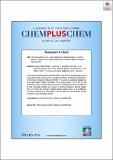The conundrum of α- and β-lapachone isomerization in acidic media : insights from experimental and implicit/explicit solvation approaches
Abstract
Combined experimental and mixed implicit/explicit solvation approaches were employed to gain insights into the origin of switchable regioselectivity of acid‐catalyzed lapachol cyclization and α‐/β‐lapachone isomerization. It was found that solvating species under distinct experimental conditions stabilized α‐ and β‐lapachone differently, thus altering the identity of the thermodynamic product. The energy profile for lapachol cyclization revealed that this process can occur with low free‐energy barriers (lower than 8.0 kcal mol−1). For α/β isomerization in a dilute medium, the computed enthalpic barriers are 15.1 kcal mol−1 (α→β) and 14.2 kcal mol−1 (β→α). These barriers are lowered in concentrated medium to 11.5 and 12.6 kcal mol−1, respectively. Experimental determination of isomers ratio was quantified by HPLC and NMR measurements. These findings provide insights into the chemical behavior of lapachol and lapachone derivatives in more complex environments.
Citation
Delarmelina , M , Nicoletti , C , de Moraes , M , Futuro , D , Buehl , M , da Silva , F , Ferreira , V & Carneiro , J W 2018 , ' The conundrum of α- and β-lapachone isomerization in acidic media : insights from experimental and implicit/explicit solvation approaches ' , ChemPlusChem , vol. Early View . https://doi.org/10.1002/cplu.201800485
Publication
ChemPlusChem
Status
Peer reviewed
ISSN
2192-6506Type
Journal article
Description
The authors are grateful to CAPES (Coordenação de Aperfeiçoamento de Pessoal de Nível Superior), CNPq (Conselho Nacional de Desenvolvimento Científico e Tecnológico), and FAPERJ (Fundação Carlos Chagas Filho de Amparo à Pesquisa do Estado do Rio de Janeiro) for funding this research project.Collections
Items in the St Andrews Research Repository are protected by copyright, with all rights reserved, unless otherwise indicated.

